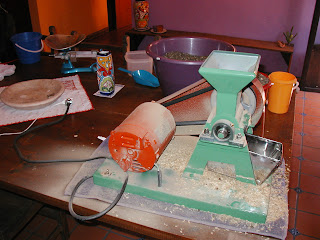Small scale coffee machinery
This holiday period we finally managed the time to get ourselves the basic machinery we need for making coffee from the beginning to the end of the process. So far as our production is concerned there are three main machines involved, not counting the simple heat sealing machine that closes up the bags of coffee.
The first machine is a despulpador. This machine basically removes the flesh off the picked beans, leaving the bean itself. We found a local business that makes these machines in various models, from the level of the hobbyist to full scale industrial machines. We bought a manual machine, where you turn the handle by hand. The wheel has provision for being hooked up to an electric motor at any time, but the machine works very efficiently by hand, and for small amounts of coffee is ideal. The heart of the machine is a large disk that has spikes on both sides of it. Beans are poured in the top and a hose with running water is pointed into the chamber. This keeps the beans moving through quickly. Once the shedding of the "pulp" is done, the beans come out the front of the machine to be gathered in a sack or bucket, and the "pulp" comes out the back, and can be used as compost. Here are some pix of our despulpador.



The second machine that comes into play is called a morteador. Once the beans have been "despulped" they are washed until all the slime is off them and then they are laid out to dry. They dry in up to a week. When dry the outer husk can be taken off, leaving the "essential bean", a much smaller green bean that is what you roast. Before looking at the morteador, here are some of our beans drying in one of the upstairs bedrooms.



The morteador we bought was made by the same local company that produces the despulpadors. It is a small unit, powered by a one horsepower electric motor. The beans are put into the funnel at the top and the motor is switched on. Each load takes a bit over 15 minutes to do, producing about a kilo of ready to roast de-husked coffee each hour. This is slow by industrial standards, but fine for our scale. Once we had worked out the time needed to husk a load we could set a timer and go off and do other things while the husking was going on. Then we'd come back, empty the husks and the beans and put on another load.





The husking generates quite a bit of dust. The morteador works by "grinding the beans between a rotating arm that has a raised twist, a bit like a meat mincer. Beans are moved within the twist and pressed up against a grill under the machine. The husks get forced through the grill and into a tray beneath. When all the husks are removed they are discarded, and the grill can then be opened, revealing the beans. These are caught in the tray that previously caught the husks, and can be loaded into large containers to wait for roasting.



The husked beans can be left for months, even years, before they are roasted, using a tostador. The machine we had built for us by a local man, Jorge, has a rotating drum over a row of gas flames. You load the beans into the heat chamber, close the chamber, light the gas and turn the handle. Our tostador can produce 8 kilos of roasted beans at a time, each load involving a patient hour of handle turning.




When the beans are roasted -- verified by turning the flame off and opening the "sliding window" to check what is inside -- they are tipped into a chute under the roasting chamber, and are raked into a bucket and then transferred to a sieve, so that any lingering huck can be removed, leaving just the nice shiny oily roasted beans. We built the sieve and so far it works just fine.






The first machine is a despulpador. This machine basically removes the flesh off the picked beans, leaving the bean itself. We found a local business that makes these machines in various models, from the level of the hobbyist to full scale industrial machines. We bought a manual machine, where you turn the handle by hand. The wheel has provision for being hooked up to an electric motor at any time, but the machine works very efficiently by hand, and for small amounts of coffee is ideal. The heart of the machine is a large disk that has spikes on both sides of it. Beans are poured in the top and a hose with running water is pointed into the chamber. This keeps the beans moving through quickly. Once the shedding of the "pulp" is done, the beans come out the front of the machine to be gathered in a sack or bucket, and the "pulp" comes out the back, and can be used as compost. Here are some pix of our despulpador.



The second machine that comes into play is called a morteador. Once the beans have been "despulped" they are washed until all the slime is off them and then they are laid out to dry. They dry in up to a week. When dry the outer husk can be taken off, leaving the "essential bean", a much smaller green bean that is what you roast. Before looking at the morteador, here are some of our beans drying in one of the upstairs bedrooms.



The morteador we bought was made by the same local company that produces the despulpadors. It is a small unit, powered by a one horsepower electric motor. The beans are put into the funnel at the top and the motor is switched on. Each load takes a bit over 15 minutes to do, producing about a kilo of ready to roast de-husked coffee each hour. This is slow by industrial standards, but fine for our scale. Once we had worked out the time needed to husk a load we could set a timer and go off and do other things while the husking was going on. Then we'd come back, empty the husks and the beans and put on another load.





The husking generates quite a bit of dust. The morteador works by "grinding the beans between a rotating arm that has a raised twist, a bit like a meat mincer. Beans are moved within the twist and pressed up against a grill under the machine. The husks get forced through the grill and into a tray beneath. When all the husks are removed they are discarded, and the grill can then be opened, revealing the beans. These are caught in the tray that previously caught the husks, and can be loaded into large containers to wait for roasting.



The husked beans can be left for months, even years, before they are roasted, using a tostador. The machine we had built for us by a local man, Jorge, has a rotating drum over a row of gas flames. You load the beans into the heat chamber, close the chamber, light the gas and turn the handle. Our tostador can produce 8 kilos of roasted beans at a time, each load involving a patient hour of handle turning.




When the beans are roasted -- verified by turning the flame off and opening the "sliding window" to check what is inside -- they are tipped into a chute under the roasting chamber, and are raked into a bucket and then transferred to a sieve, so that any lingering huck can be removed, leaving just the nice shiny oily roasted beans. We built the sieve and so far it works just fine.








0 Comments:
Post a Comment
<< Home